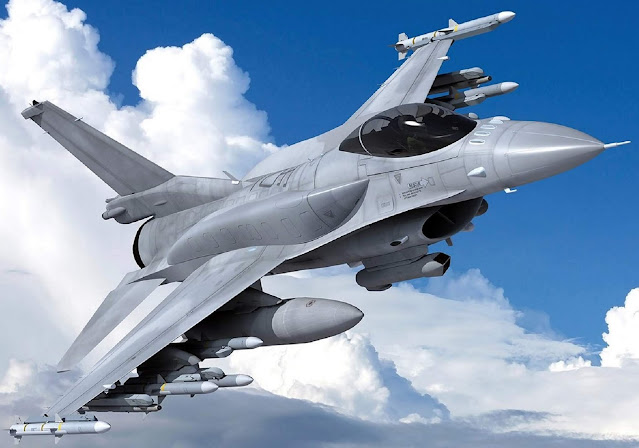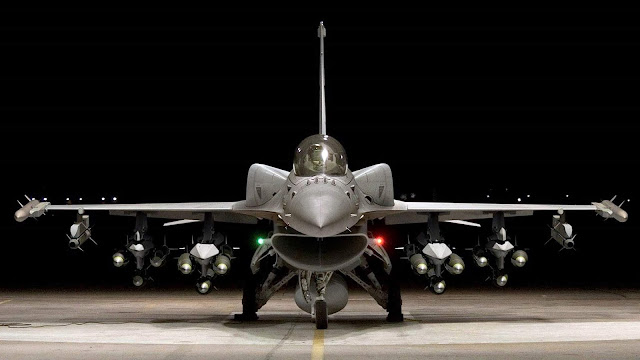 |
| A Computer Generated Image (CGI) of an F-16V Viper. Photo courtesy of the official Lockheed Martin website |
This is the second and last of two blogs I made about the F-16V Block 70/72 Viper aircraft for the Philippine Air Force (PAF), you can access the first one here: The F-16V Block 70/72 Viper for the Philippine Air Force? – Part One
’Operating Costs’No data is available yet for the Operating Costs or Cost Per Flight Hour (CPFH) of the F-16V, but some data are available for its older version, the F-16C. Calculating CPFH though is a bit tricky since there is no standard way of doing it, so instead of citing just one figure I am just going to give a range of figures if enough data is available.
For the F-16C, its CPFH ranges from as low as Usd 7,000 per hour1 to as high as Usd 22,470 per hour.2 This is generally higher than the Gripen whose CPFH ranges from as low as Usd 4,700 per hour to as high as Usd 13,350 per hour.3
The F-16V’s AESA radar requires less maintenance and thus have lower maintenance costs than the MSA radar on the F-16C, but no data yet up to what degree exactly it will be lower and how it will affect the overall CPFH of the aircraft.
’Dispersed Operations’
In my blog about the Gripen in 2018,4 I wrote about China’s ability to hit any target in the Philippines including Airfields using Ballistic and/or Cruise Missiles. This why I think it is important for our Air Force to be able to do “Dispersed Operations” (meaning to operate from other areas aside from just Runways) also.
Now the Viper can definitely do Dispersed Operations also, many countries do practice operating from roads with their F-16s regularly, but the Viper will be able to do it to a lesser degree than the Gripen which was designed from the outset to do it.
For example, the Gripen can be serviced by Conscripts after only 10 weeks of Training. It has Special Manual Tools housed in Mobile Trailers that allows the servicing of the aircraft. I can’t find any such equivalent with the F-16 wherein Dispersed Operations is deeply embedded or part of the Design Philosophy or Doctrine of the aircraft.
’Aerial Refueling’5 6
The F-16 usually comes with a Boom Receptacle for Aerial Refueling using the Flying Boom method, although LM is also offering an option for a Refueling Probe7 to be installed on it for use with the Hose and Drogue method.
Both methods have their Pros and Cons, hence it might be a good idea for the PAF to determine which one they prefer to go with early on.
The Flying Boom method transfers fuel up to three times faster and provides less work on the part of the Pilot during refueling, but is a more complicated system and thus more expensive to acquire and maintain. It also allows only one aircraft to be refueled at a time, and less Air Forces and aircraft types use it.
On the other hand, the Hose and Drogue method allows at least two aircraft to be refueled at a time, and it is simpler and less complicated thus cheaper to acquire and maintain. More Air Forces and aircraft types also adopt it. However, it is up to three times slower in transferring fuel and requires more effort on the part of the Pilot during refueling.
Worst case is to just install both systems on the F-16V allowing flexibility on which type of Aerial Tanker can refuel it which could be important when we are working with allies. It will add costs to the aircraft, though.
’Spare Parts as Political Tools’
One thing to be wary though when buying from the US like with the F-16 though is that they have a bad habit of using the supply of their weapons and spare parts as a Political Tool when countries do something that they don’t like.
A good example of this is Indonesia which first bought F-16s in the mid-1980s. But then the US imposed an Arms Embargo on them in 1999 due to their Military intervention in East Timor.
As a result of that the Combat Readiness of Indonesia’s F-16 Fleet was severely affected due to the lack of Spare Parts. The embargo was eventually lifted in 2005, and Indonesia did end up buying more F-16s after the embargo was lifted. But they also continued to operate Russian Su-30 Flanker aircraft alongside their F-16s to this day.8
The Philippines itself reportedly was at the receiving end of such an embargo in 1968 during the Philippines’ dispute with Malaysia over the island of Sabah as recounted by retired PAF Col. Samson Mahimer in a Research Report back in 1988.9
The US apparently sided with Malaysia on the Sabah issue and thus the spare parts for the American made aircraft used by the PAF then suddenly became scarce due to some dubious reasons.
’Restrictions for Use’
Another issue is how the US tends to put restrictions on military equipment bought from them, like with Pakistan’s F-16s for example. The US only allowed Pakistan to base their F-16s on two approved Bases, and didn't allow Pakistan to use the F-16s against any other country, they are supposedly for counter terrorism purposes only.10
Of course Pakistan’s situation is different from ours and it seems that the US tailors its restrictions on a case to case basis depending on the country also, but this is something that we need to be aware of and should be discussed up front if we are to buy F-16s from them.
’Delivery Schedule’
The F-16V’s success in terms of getting orders in the last couple of years is good for the manufacturer, but could be a concern for customers who are in a hurry to acquire them. Both the JAS-39C and Su-30SME has not been as successful yet in terms of getting orders recently, but that means delivery time is less of an issue with them also.
As per my last count, the F-16V’s firm orders or where Contracts have been signed already total 286 upgraded and brand new aircraft from Taiwan, Bahrain, Greece, Slovakia and Bulgaria. Other F-16V orders from Taiwan and Morocco totaling 114 aircraft are still pending Contract Signing.
Now as per LM, their Production Facility in Greenville, South Carolina can produce a maximum of four aircraft per month (both for upgraded and brand new aircraft) or 48 per year.11
This means that at maximum capacity, LM will be able to complete the firm orders in six years. If the pending orders becomes firm when the Contracts are signed, then that will add another two years to the Production Schedule.
So for now, the delivery of the F-16V will be at least up to 2026. If the pending orders firm up, then that will move the deliveries out to at least 2028.
This is of course just for the Greenville Plant at its maximum capacity, LM may have some solutions up its sleeve that will enable them to increase their production capacity and thus make the deliveries sooner.
For example, they might be able to somehow increase the capacity of their plant, or maybe just open up another plant altogether especially if more orders come in. At any rate, this is something that the PAF needs to take up closely with the manufacturer if they are indeed going to buy the F-16V.
’Political Roadblock’
One big problem with the F-16V though is that it is made as a complete military product in the US and any sale of it will require approval by the US Senate, and right now relations between them and the Duterte Administration has not been very good, to say the least.
For one, the US Senate recently introduced a Resolution in the US’ 2020 Budget sanctioning Officials of the Duterte Administration for the incarceration of Philippine Senator Leila De Lima.12
The Philippine Government on the other hand has retaliated by issuing a Travel Ban into the Philippines to three US Senators as of this writing.13 With all these animosity going on between the two sides, there is a possibility that the US Senate may not be inclined to approve any sale of military equipment anymore to the Philippines.
Of course we really can’t truly be sure 100% until it actually happens, but the possibility I feel is there for every transaction. On the Philippine side, one wonders if the Duterte Administration itself would even want to buy any military equipment at all from the US, given all that has happened so far.
Note that this is a developing story, the situation may even get worst once the US releases the list of Officials that will be sanctioned.
’Parting Shot’
I think that the F-16V has clear advantages over the Gripen C in terms of Range, Endurance, Payload and Radar Technology, but this comes at the cost of a higher CPFH and less Dispersed Operations capability.
It might also come with some Political Baggage like the need to be constantly politically favorable to the US to maintain the supply of weapons and parts, possible restrictions of use and even possible denial of the sale of the aircraft to the Philippines.
Lastly there is also the delivery schedule which needs to be worked out. But to its credit notice though that most of the issues I noted above about the F-16V were mostly not related to the technical capability of the aircraft, they are more of “peripheral” issues, especially the political ones.
This means that if we can find some solutions to those issues, then the F-16V could still be very much a viable aircraft for the PAF. The political issues are bound to continue after this blog is posted, so we will need to keep a close watch on it.
 |
| Front view of an F-16V Viper. Photo courtesy of the official Lockheed Martin website |
SOURCES:
- Fast Jet Operating Costs – Cost per Flight Hour Study of Selected Aircraft
- Selected Acquisition Report (SAR) – F-35
- South Africa’s Sad Military: Why Maintenance Matters
- The JAS-39C/D Gripen for the Philippine Air Force? – Part Two
- Aerial Refueling: The Need for a Multipoint, Dual-System Capability
- How Airplanes Refuel in the Air (Aerial Refueling)
- The F-16 gets a Conformal Aerial Refueling Tank System (CARTS)
- Indonesia on the F-16.net Website
- United States-Philippines Bases Agreement: Prospect for its Renewal by Samson M. Mahimer
- State Department reprimanded Pakistan for misusing F-16s, Document shows
- Lockheed Martin sees big demand for F-16 in Middle East & Asia
- Trump signs Law banning De Lima Jailers from entering US
- Duterte bans US Sen. Markey from entering PHL for calling for De Lima release

No comments:
Post a Comment